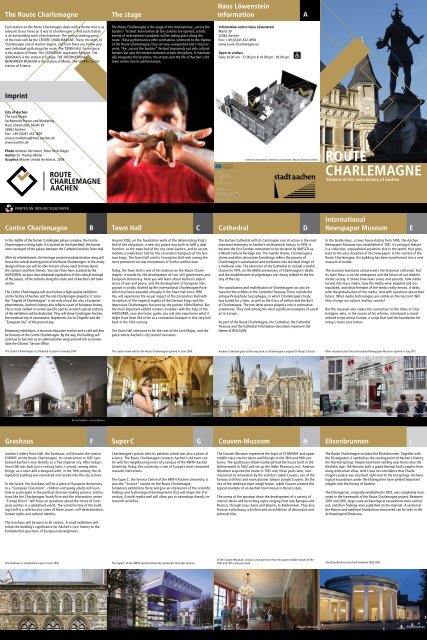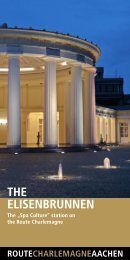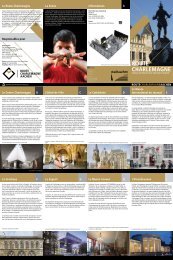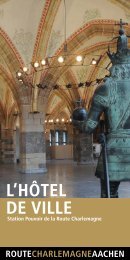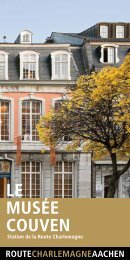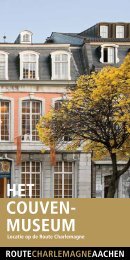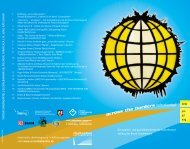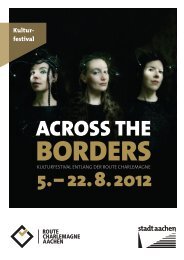Grashaus - Route Charlemagne Aachen
Grashaus - Route Charlemagne Aachen
Grashaus - Route Charlemagne Aachen
You also want an ePaper? Increase the reach of your titles
YUMPU automatically turns print PDFs into web optimized ePapers that Google loves.
The <strong>Route</strong> <strong>Charlemagne</strong><br />
Stage The stage<br />
Haus Löwenstein<br />
Information<br />
A<br />
Each station on the <strong>Route</strong> <strong>Charlemagne</strong> deals with a theme that is as<br />
relevant to our times as it was to <strong>Charlemagne</strong>‘s. And each station<br />
is an outstanding work of architecture. The central starting point<br />
of the route will be the CENTRE CHARLEMAGNE. There, the story of<br />
<strong>Charlemagne</strong> and of <strong>Aachen</strong> begins, and from there you follow your<br />
own individual path along the route. The TOWN HALL for instance<br />
is the station of Power. The CATHEDRAL represents Religion. The<br />
GRASHAUS is the station of Europe. THE INTERNATIONAL<br />
NEWSPAPER MUSEUM is the station of Media. The SUPER C is the<br />
station of Science.<br />
The <strong>Route</strong> <strong>Charlemagne</strong> is the stage of the international „across the<br />
borders“ festival. Even before all the stations are opened, artistic<br />
events of international standards will be taking place along the<br />
route. These performances offer contrastive comments to the themes<br />
of the <strong>Route</strong> <strong>Charlemagne</strong>; they set new, unexpected and critical accents.<br />
The „across the borders“ festival transcends not only cultural<br />
borders but also the borders between artistic disciplines. It intentionally<br />
integrates the locations, the streets and the life of <strong>Aachen</strong>‘s old<br />
town centre into its performances.<br />
Information centre Haus Löwenstein<br />
Markt 39<br />
52062 <strong>Aachen</strong><br />
Fon: +49 (0)241 432-4994<br />
www.route-charlemagne.eu<br />
Open to visitors<br />
Daily 10.00 am - 13.00 pm & 14.00 pm - 18.00 pm<br />
Imprint<br />
City of <strong>Aachen</strong><br />
The Lord Mayor<br />
Fachbereich Presse und Marketing<br />
Haus Löwenstein, Markt 39<br />
52062 <strong>Aachen</strong><br />
Fon: +49 (0)241 432-1309<br />
presse.marketing@mail.aachen.de<br />
www.aachen.de<br />
Photo Andreas Herrmann, Peter Hinschläger<br />
Author Dr. Thomas Müller<br />
Graphics Maurer United Architects, 2009<br />
Overview Information centre Haus Löwenstein: Maurer United Architects<br />
ROUTE<br />
CHARLEMAGNE<br />
Stations of the town history of <strong>Aachen</strong><br />
PRINTED ON 100% RECYCLED PAPER<br />
Centre <strong>Charlemagne</strong><br />
International<br />
B Town Hall<br />
C Cathedral<br />
D Newspaper Museum E<br />
In the middle of the former Carolingian palace complex, the Centre<br />
<strong>Charlemagne</strong> is being built. It is located on the Katschhof, the former<br />
inner courtyard of the palace between the Cathedral and the Town Hall.<br />
After its refurbishment, the heritage-protected administrative wing will<br />
house the central starting point of the <strong>Route</strong> <strong>Charlemagne</strong>. In the newly<br />
designed foyer you will be able to learn all you need to know about<br />
the stations and their themes. You start from here, assisted by the<br />
AIXPLORER, on your own individual exploration of the cultural heritage<br />
of the palace, of the stations along the route and of <strong>Aachen</strong>’s old town<br />
centre.<br />
The Centre <strong>Charlemagne</strong> will also feature a high-quality exhibition<br />
on the history of <strong>Aachen</strong> and the role <strong>Charlemagne</strong> played in it. Since<br />
the “Legend of <strong>Charlemagne</strong>” is not only a local but also a European<br />
phenomenon, <strong>Aachen</strong>’s history also reflects a part of European history.<br />
This is most evident in certain specific epochs to which special sections<br />
of the exhibition will be dedicated. They will show Carolingian <strong>Aachen</strong>,<br />
the medieval city of coronations, Napoleonic Aix-la-Chapelle and the<br />
“European city“ of the present day.<br />
Temporary exhibitions, a museum education section and a café will also<br />
be features of the Centre <strong>Charlemagne</strong>. By the way, the building will<br />
continue to function as an administrative wing and will still accommodate<br />
the Citizens’ Service Office.<br />
Around 1350, on the foundation walls of the deteriorating King’s<br />
Hall of the old palace, a new city palace was built to fulfil a dual<br />
function: as the town hall of the city-state <strong>Aachen</strong>, and to accommodate<br />
a celebration hall for the coronation banquets of the German<br />
kings. The Town Hall and its Coronation Hall rank among the<br />
most prominent secular monuments of Gothic architecture.<br />
Today, the Town Hall is one of the stations on the <strong>Route</strong> <strong>Charlemagne</strong>.<br />
It stands for the development of civic self-government and<br />
European democracy. Here you will learn about <strong>Aachen</strong>’s experiences<br />
of war and peace, and the development of European integration<br />
is vividly charted by the International <strong>Charlemagne</strong> Prize,<br />
which has been awarded annually in the Town Hall since 1950.<br />
You will experience the visual impact of the Coronation Hall with<br />
its replicas of the imperial regalia of the German kings and the<br />
impressive <strong>Charlemagne</strong> Frescoes by the painter Alfred Rethel. But<br />
the most important exhibit remains invisible: with the help of the<br />
AIXPLORER, your electronic guide, you will also experience what it<br />
might have been like to be at a coronation banquet in this very hall<br />
back in the 16th century.<br />
The Town Hall continues to be the seat of the Lord Mayor, and the<br />
place where <strong>Aachen</strong>’s city council convenes.<br />
The <strong>Aachen</strong> Cathedral with its Carolingian core structure is the most<br />
important testimony to <strong>Aachen</strong>’s ecclesiastical history. In 1978, it<br />
became the first German monument to be declared by UNESCO as<br />
a World Cultural Heritage site. The marble throne, <strong>Charlemagne</strong>’s<br />
shrine and other decorative furnishings reflect the process of<br />
<strong>Charlemagne</strong>’s sacralisation and stylisation into the ideal image of<br />
a medieval ruler. The extension of the Cathedral to include a Gothic<br />
chancel in 1414, on the 600th anniversary of <strong>Charlemagne</strong>’s death,<br />
and the establishment of pilgrimages are closely related to the history<br />
of the city.<br />
The sacralisation and mythification of <strong>Charlemagne</strong> can also be<br />
traced in the exhibits in the Cathedral Treasury. These include the<br />
antique Persephone Sarcophagus, in which <strong>Charlemagne</strong>’s body<br />
was buried for a time, as well as the Cross of Lothair and the Bust<br />
of <strong>Charlemagne</strong>. The two latter pieces played a role in coronation<br />
ceremonies. They rank among the most significant examples of sacral<br />
art in Europe.<br />
As part of the <strong>Route</strong> <strong>Charlemagne</strong>, the Cathedral, the Cathedral<br />
Treasury and the Cathedral Information document represent the<br />
theme of RELIGION.<br />
In the Große Haus, a town house dating from 1495, the <strong>Aachen</strong><br />
Newspaper Museum was established in 1931. Its principal feature<br />
is a collection, unparalleled anywhere else in the world, that goes<br />
back to the very inception of the newspaper. In the context of the<br />
<strong>Route</strong> <strong>Charlemagne</strong>, the building has been transformed into a new<br />
museum of media.<br />
The museum maintains and presents the historical collection. But<br />
its main focus is on the emergence and the future of our modern<br />
media society. It shows how news arises and spreads, how media<br />
turned into mass media, how the media were adapted and manipulated,<br />
and what freedom of the media really means. It deals<br />
with the globalisation of the media. And with questions about their<br />
future. What media technologies are visible on the horizon? Will<br />
they change our culture and our society?<br />
But the museum also makes the connection to the times of <strong>Charlemagne</strong>,<br />
who, in the course of his reforms, introduced a standardised<br />
script across Europe, a script that laid the foundation for<br />
today’s lower-case letters.<br />
The Centre <strong>Charlemagne</strong> is scheduled to open in January 2014. The station Town Hall on the <strong>Route</strong> <strong>Charlemagne</strong> opened in June 2009. <strong>Aachen</strong> Cathedral goes all the way back to <strong>Charlemagne</strong>’s original St Mary’s Church. After reconstruction the International Newspaper Museum opened in July 2011.<br />
Exhibition Centre <strong>Charlemagne</strong> Coronation Hall Cathedral International Newspaper Museum<br />
hks Architekten + Gesamtplaner<br />
<strong>Grashaus</strong><br />
F Super C G Couven-Museum H Elisenbrunnen<br />
I<br />
<strong>Aachen</strong>’s oldest Town Hall, the <strong>Grashaus</strong>, will become the station<br />
EUROPE on the <strong>Route</strong> <strong>Charlemagne</strong>. Its construction in 1267 symbolised<br />
<strong>Aachen</strong>’s new identity as a free imperial city. After today’s<br />
Town Hall was built just a century later, it served, among other<br />
things, as a court and a dungeon until, in the 19th century, the dilapidated<br />
building was renovated and turned into the city archive.<br />
In the future, the <strong>Grashaus</strong> will be a place of European democracy.<br />
In a “European Classroom”, children and young adults will learn<br />
how to participate in the political decision-making process. Institutions<br />
like the <strong>Charlemagne</strong> Youth Prize and the information centre<br />
“Europe Direct” will focus on questions about the future of European<br />
politics in a globalised world. The varied history of the building<br />
itself is a reference to some of these issues: self-determination,<br />
human rights and cultural identity.<br />
<strong>Charlemagne</strong>’s palace with its palatine school was also a place of<br />
science. The <strong>Route</strong> <strong>Charlemagne</strong> connects <strong>Aachen</strong>’s old town centre<br />
with the neighbouring inner city campus of the RWTH <strong>Aachen</strong><br />
University. Today, this university is one of Europe’s most renowned<br />
research institutions.<br />
The Super C, the Service Centre of the RWTH <strong>Aachen</strong> University, is<br />
also the “Science” station on the <strong>Route</strong> <strong>Charlemagne</strong>.<br />
Temporary exhibitions there will give an impression of the scientific<br />
findings and technological developments that will shape the 21st<br />
century. A multi-media wall will allow you to eavesdrop directly on<br />
research activities.<br />
The Couven-Museum represents the topic of ECONOMY and upper<br />
middle-class interior decor and lifestyle in the 18th and 19th centuries.<br />
The apothecary Adam Coebergh had the house built at the<br />
Hühnermarkt in 1662 and set up the Adler Pharmacy in it. Andreas<br />
Monheim acquired the house in 1783 and, three years later, commissioned<br />
its renovation by the architect Jakob Couven, son of the<br />
famous architect and town planner Johann Joseph Couven. On the<br />
site of the medieval town weigh house, Jakob Couven created this<br />
typical example of an <strong>Aachen</strong> town house in Rococo style.<br />
The rooms of the museum show the development of a variety of<br />
interior decor and furnishing styles ranging from late Baroque and<br />
Rococo, through Louis-Seize and Empire, to Biedermeier. They also<br />
feature a pharmacy, a kitchen and an exhibition of decorative and<br />
pictorial tiles.<br />
The <strong>Route</strong> <strong>Charlemagne</strong> includes the Elisenbrunnen. Together with<br />
the Elisengarten, it symbolises the starting point of <strong>Aachen</strong>’s history:<br />
the thermal springs. People have been settling near them since the<br />
Neolithic Age. The Romans built a grand thermal bath complex here,<br />
along with urban villas. And it was no coincidence that <strong>Charlemagne</strong>’s<br />
palace was also built right next to the hot springs. Archaeological<br />
excavations under the Elisengarten have yielded important<br />
insights into the history of <strong>Aachen</strong>.<br />
The Elisengarten, originally established in 1851, was completely renovated<br />
in the framework of the <strong>Route</strong> <strong>Charlemagne</strong> project. Between<br />
2007 and 2010, large-scale archaeological excavations were carried<br />
out, and their findings were published on the Internet. A section of<br />
the Roman and medieval foundations discovered can be seen in the<br />
Archaeological Showcase.<br />
The <strong>Grashaus</strong> will be open to all visitors. A small exhibition will<br />
relate the building’s significance for <strong>Aachen</strong>’s civic history to the<br />
fundamental questions of European development.<br />
The <strong>Grashaus</strong> is scheduled to open in late 2014.<br />
The Super C of the RWTH <strong>Aachen</strong> University represents the topic Science.<br />
In the Couven-Museum, visitors can experience how the upper middle classes of the<br />
18th and 19th centuries lived.<br />
The Elisenbrunnen was built between 1822-1827.<br />
<strong>Grashaus</strong> Super C Couven-Museum Elisenbrunnen
0 10 50 100m<br />
Templergraben<br />
Hirschgraben<br />
Seilgraben<br />
Pontstraße<br />
Neupforte<br />
Templergraben<br />
Augustinerbach<br />
Pontstraße<br />
Kleinkölnstraße<br />
Eilfschornsteinstraße<br />
Markt<br />
Annuntiatenbach<br />
Büchel<br />
Büchel<br />
Katschhof<br />
Hof<br />
Peterstraße<br />
Trichtergasse<br />
Jakobstraße<br />
Ursulinerstraße<br />
Fischmarkt<br />
Münsterplatz<br />
Jakobstraße<br />
Jesuitenstraße<br />
Hartmannstraße<br />
Friedrich-Wilhelm-Platz<br />
Kleinmarschierstraße<br />
Haus Löwenstein<br />
Centre <strong>Charlemagne</strong><br />
<strong>Grashaus</strong><br />
Town Hall<br />
Super C<br />
Cathedral and Cathedral Treasury<br />
Alexianergraben<br />
Couven-Museum<br />
International Newspaper Museum<br />
Elisenbrunnen<br />
<strong>Aachen</strong> is a Historical City<br />
<strong>Aachen</strong> is a City of Science<br />
<strong>Aachen</strong> is a European City<br />
<strong>Charlemagne</strong> lived<br />
from 748 to 814<br />
<strong>Aachen</strong>s history reflects the history of Europe. Founded around thermal<br />
springs, the city grew, following a Roman and then a medieval<br />
pattern. At its centre stood <strong>Charlemagne</strong>‘s palace and his St. Mary‘s<br />
Church. This complex became part of a network of palaces, abbeys<br />
and courts that extended across the whole of the Carolingian empire.<br />
After his death, <strong>Charlemagne</strong> became a legend, and this legend<br />
has remained an integral part of the city‘s history to this very day.<br />
<strong>Charlemagne</strong>‘s tomb, his throne and his palace are now memorial<br />
sites of European heritage. But they are also a part of a city that has<br />
a firm eye on the future and seeks the answers to the great questions<br />
of the 21st century.<br />
The interconnection of science with art and culture was a fundamental<br />
principle of Carolingian rule. <strong>Charlemagne</strong> had the scattered<br />
works of ancient authors gathered together again. He documented<br />
the traditions of the enemies he conquered and called scholars from<br />
all over Europe to the palatine school he founded here in <strong>Aachen</strong>:<br />
astronomers and theologians, mathematicians and architects alike.<br />
Without the copies that were produced at this school, we would no<br />
longer be in possession of a major part of ancient literature. Today,<br />
<strong>Aachen</strong> hosts four well-established colleges, and science is a decisive<br />
location factor for the city. Nowhere in Europe today are there so<br />
many colleges and research centres as here in the region surrounding<br />
the cities of Maastricht, Liège and <strong>Aachen</strong>.<br />
In <strong>Charlemagne</strong>‘s times, <strong>Aachen</strong> was the centre of an empire that<br />
stretched from the North Sea to Central Italy and from the Pyrenees<br />
to the River Elbe. The integration of the peoples living in the<br />
Carolingian empire and centralisation of governance were two<br />
of <strong>Charlemagne</strong>‘s major political achievements. The subsequent<br />
division of his empire, in a long historical process, gave rise to the<br />
nations France and Germany. After the end of the Second World War,<br />
of National Socialism and its crimes against humanity, the European<br />
democracies began the process of forging a united and peaceful<br />
Europe. The border town of <strong>Aachen</strong> became a European city. With<br />
its <strong>Charlemagne</strong> Prize, it invoked the heritage of <strong>Charlemagne</strong> and<br />
created a symbol of modern European politics.<br />
With a sweeping and still highly controversial policy of expansionism,<br />
<strong>Charlemagne</strong> built a huge empire. He initiated political,<br />
economic and cultural reforms manifested in the introduction of a<br />
common Christian faith, a standardised script and a common currency.<br />
<strong>Charlemagne</strong>‘s imperial coronation by Pope Leo III in Rome<br />
in 800 marked the legitimisation of this medieval empire. One of<br />
the grandest attestations to the cultural glory of his times is the St.<br />
Mary‘s Church that <strong>Charlemagne</strong> built in <strong>Aachen</strong>, today‘s Cathedral.<br />
Here, after his death, <strong>Charlemagne</strong> was entombed, and for<br />
this reason the German kings were crowned here from 936 to 1531.<br />
Charle-magne was glorified as the epitome of an ideal ruler.


